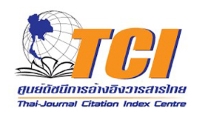JOURNAL DETAIL
Subsurface structure of Kanchanaburi area interpreted from aeromagnetic data
Paper Type |
Contributed Paper |
Title |
Subsurface structure of Kanchanaburi area interpreted from aeromagnetic data |
Author |
Dhiti Tulyatid [a] and Wanida Rangubpit [b] |
Email |
dr.dhiti@gmail.com |
|
Abstract: The Three Pagoda Fault Zone (TPFZ) is believed to have developed as a consequence of the Indian-Eurasian Collision, and is considered to originally have been a major left lateral shear zone activated during the Eocene - Oligocene. The fault zone probably reversed its movement to right lateral motion in Early Miocene, marking the opening of the Gulf of Thailand and the Central Plain. The fault zone may have had little or no slip in post mid-Miocene time before reactivation with right-lateral transpression in Pliocene to Holocene. A number of studies have suggested that only the most northwestern part of the TPFZ in Thailand is currently active. The interpretation of aeromagnetic data covering the area over Kanchanaburi and vicinity reveals distinct sets of lineaments believed to be associated with basement structure. Aeromagnetic anomalies have led us to suggest that the dextral-strike-slip movement of TPFZ may be associated with igneous intrusion occurred at the depths of approximately 1000 – 1500 m from the surface. The anomalies strongly reveal the SE-extension of the buried TPFZ path running through downtown Kanchanaburi (Tha Muang and Tha Maka Districts), parts of Ratchaburi and Nakhon Pathom Provinces, and through the southern part of the Bangkok Metropolitan region. Field studies have been carried out to preliminarily evaluate the existence of the major fault. This buried fault may become the location of future seismic activity located at or near to city centers along its path.
|
|
Start & End Page |
1316 - 1323 |
Received Date |
2016-04-12 |
Revised Date |
|
Accepted Date |
2016-07-08 |
Full Text |
Download |
Keyword |
aeromagnetic, Three Pagoda Fault, structural geology |
Volume |
Vol.43 No.6 (SPECIAL ISSUE 2) |
DOI |
|
Citation |
[a] D.T. and [b] W.R., Subsurface structure of Kanchanaburi area interpreted from aeromagnetic data, Chiang Mai Journal of Science, 2016; 43(6): 1316-1323. |
| View:835 Download:404 | |
RELATED ARTICLE
Structural Analysis of part of the Nigerian South-western Basement Complex using aeromagnetic data
page: 1324 - 1334
Author:John S. Kayode*, Mohd Nawawi and Khiruddin Abdullah
Vol.43 No.6 (SPECIAL ISSUE 2) View: 796 Download:500
page: 1324 - 1334
Author:John S. Kayode*, Mohd Nawawi and Khiruddin Abdullah
Vol.43 No.6 (SPECIAL ISSUE 2) View: 796 Download:500
Copyrights © Since 2021 All Rights Reserved by Chiang Mai Journal of Science










